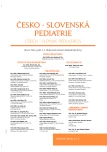Female genital tract congenital anomalies – development defects of Müllerian ducts and their derivatives – ultrasound diagnosis in pediatric and adolescent gynecology
Authors:
D. Smetanová
Authors‘ workplace:
GENNET, s. r. o., Praha
Published in:
Čes-slov Pediat 2020; 75 (3): 137-141.
Category:
Overview
Mullerian anomalies occur on the basis of faulted organogenesis, fusion and resorption of Mullerian ducts. Prevalence of these anomalies is stated in a wide range. This data varies between different authors but can also be inconsistent in individual publications of one author. These may oftentimes be connected to other anomalies, in particular kidney anomalies, therefore it is important to take that into account during the examination.
In the pediatric and adolescent population are these anomalies predominantly diagnosed incidentally, during an unrelated examination. On the contrary, in pubescent patients, evaluated due to primary amenorhoe or cyclic increasing stomach pain, we have to seek out for them.
Ultrasound examinations belong among the first-choice screening methods. However, even the ultrasound examinations have certain limitations. MRI is becoming the screening reference standard. The examination of pediatric and adolescent patients should be approached with the intent to minimize trauma for the patient. Surgical treatment is adapted to the specific anomaly and may differ in particular groups.
Keywords:
ultrasound – Mullerian duct anomalies – MRI
Sources
1. Grundwald E. The relation of the growing Müllerian duct to the Wolffian duct and its importace for the genesis of malformations. Anat Rec 1941; 81: 1–19.
2. Hořejší J. Dětská gynekologie. Praha: Avicenum, 1990: 1–281.
3. Junqueira BLP, et al. Müllerian duct anomalies and mimics in children and adolescents: Correlative intraoperative assessment with clinical imaging. RadioGraphics 2009; 29: 1085–1103.
4. Epelman M, Dinan D, Gee MS, et al. Müllerian duct and related anomalies in children and adolescents. Magn Reson Imaging Clin N Am 2013; 21 (4): 773–789.
5. Behr SC, Courtier JL, et al. Imaging of Müllerian duct anomalies. Radiographics 2012; 32 (6): 233–250.
6. Amesse LS. Mullerian duct anomalies. WebMD 2016.
7. Chan YY, Jayaprakasan K, Zamora J, et al. The prevalence of congenital uterine anomalies in unselected and high-risk populations: a systematic review. Hum Reprod Update 2011; 17: 761.
8. Chan YY, Jayaprakasan K, Tan A, et al. Reproductive outcomes in women with congenital uterine anomalies: a systematic review. Ultrasound Obstet Gynecol 2011 Oct; 38 (4): 371–382. doi: 10.1002//uog.10056.
9. Ribeiro SC, Tormena RA, Peterson TV, et al. Mullerian duct anomalies: review of € current management. Sao Paulo Med J 2009; 127: 92.
10. The American Fertility Society classifications of adnexal adhesions, distal tubal occlusion, tubal occlusion secondary to tubal ligation, tubal pregnancies, Müllerian anomalies and intrauterine adhesions. Fertil Steril 1988; 49: 944.
11. Grigoris F, et al. The ESHRE/ESGE consensus on the classification of female genital tract congenital anomalies. Hum Reprod 2013 Aug; 28 (8): 2032–2044.
12. Graupera B, Pascual MA, Hereter L, et al. Accuracy of three-dimensional ultrasound compared with magnetic resonance imaging in diagnosis of Müllerian duct anomalies using ESHRE–ESGE consensus on the classification of congenital anomalies of the female genital tract. Ultrasound Obstet Gynecol 2015; 46 (5): 616–622.
13. Hořejší J, a kol. Dětská gynekologie. Praha: Mladá fronta, 2017: 1–90.
14. Yadav P. Magnetic resonance imaging in diagnosis and classification of uterovaginal congenital anomalies. Med J DY Patil Univ 2017; 10: 510–516.
Labels
Neonatology Paediatrics General practitioner for children and adolescentsArticle was published in
Czech-Slovak Pediatrics

2020 Issue 3
Most read in this issue
- Genital bleeding in childhood view by pediatric gynecologist
- Abdominal pain at girls in childhood and adolescent age
- Female genital tract congenital anomalies – development defects of Müllerian ducts and their derivatives – ultrasound diagnosis in pediatric and adolescent gynecology
- Eisenmenger syndrome and complications in children – case report
